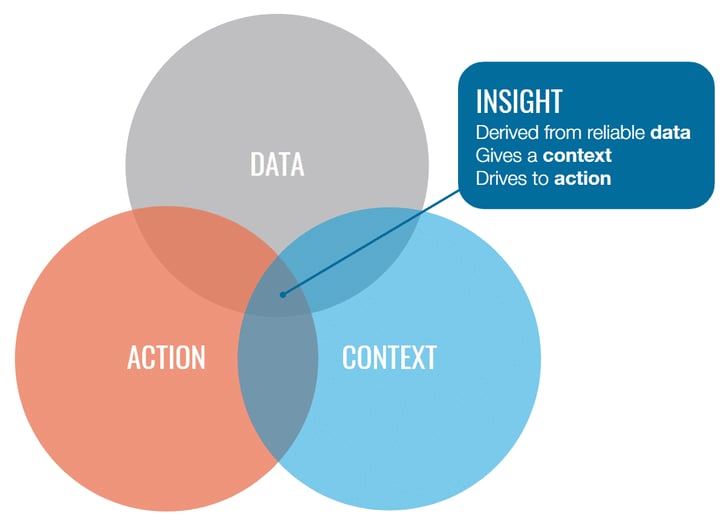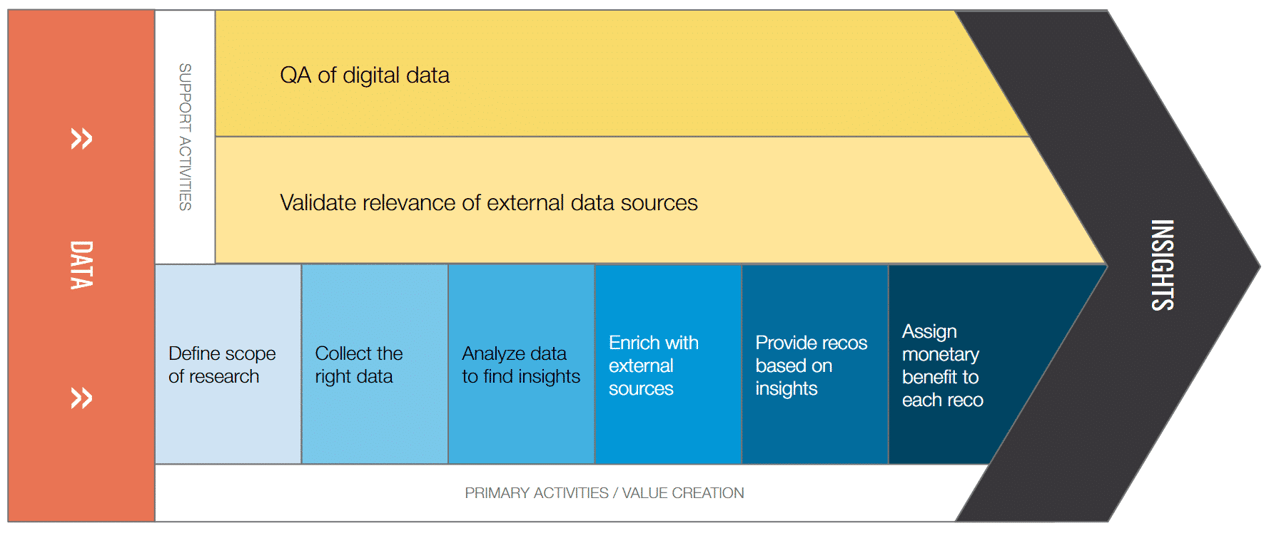Vice-President Data & Customer Experience
How to turn your data into actionable insights [Framework]
Vice-President Data & Customer Experience
Your company’s digital data should help you make decisions and take action. Is it the case yet?
It is no secret that the amount of data and reports available in Google Analytics or Adobe Analytics can quickly become overwhelming. The big challenge? Turning digital analytics data into actionable insights for your business. This article is not about segmentation techniques. It’s about giving you a simple and intuitive framework to help you tackle this important challenge.
But first, what is an insight?
Let’s start by defining what an insight is, according to the Oxford dictionary:
Insight: The capacity to gain an accurate and deep understanding of someone or something.
From a digital analytics perspective, insights are often related to the type of information that might help you improve the organization’s performance through digital initiatives (paid media, A/B tests, SEO, etc.).
But what does it take to generate good insights?
The 3 key components of meaningful insights
Good insights are like good meals, you need the right ingredients. Or, as one of my colleagues likes to say, “Garbage in, garbage out.” Many digital analytics reports are simply lists of facts. For instance, statements like the first example below might be presented as insights:
Example 1:
“In 2018, we reached $1M in eCommerce revenue; this is a 5% increase compared to the previous year.”
While the information above might be important when it comes to performance measurement, it doesn’t constitute an insight. The information doesn’t provide a good understanding of what drove this growth and what action can be taken to reproduce this behaviour.
Example 2:
“In 2018, we reached $1M in eCommerce revenue (+5% Year Over Year); this growth is attributed to the introduction of our new product X in Quebec and Ontario. Sales volume for this product over indexes in these regions compared to other provinces.”
Example two gives a better understanding of the increase in sales volume. If you think back to the definition of an insight from the Oxford dictionary, the words “gain an accurate and deep understanding of […] something” make total sense now!
This leads me to one important question when searching for insights: which are the key ingredients you should consider? This is not an exhaustive list, but the three components listed below will give you a good foundation.

(PARENTHESIS) Before searching for insights, you should know your company’s business goals. You should also know what KPIs (Digital KPIs) are assigned to these goals. The insights you are trying to produce should impact these KPIs and tactical metrics. It strongly helps if you have a set of hypotheses to start with or a set of business questions (aligned with your business goals).
1. DATA
Accuracy
There can be no insights without data (qualitative or quantitative). One property of data quality is accuracy. Your digital data should give a good approximation of what’s really going on. Auditing your data might be a good start to assess its trustworthiness. Follow the best practice: compare your digital analytics data (eCommerce transactions, web form leads) to your internal or back-end data.
Completeness
You will often need more than your digital analytics platform data to build strong insights, and tapping into external sources will help you build better stories. Resources like Google Barometer, Google Think and eMarteker can help you enrich your data points. Online surveys (to collect attitudinal data) are another easy way to enrich your data and strengthen your insights.
2. CONTEXT
Context often gives meaning to the data. Data without context is useless. Any analytics books, literature or digital analytics thought leaders (like Avinash Kaushik) will always stress the importance of putting data into context. The context is often framed by the question driving your search for insights (why are you looking for insights?) and the potential users of these insights (Marketing, Finance, Executive).
Putting the data into context involves comparing it to something or enriching your data points. Here are examples of activities that might help contextualize your data:
- Comparing your data to a business goal or target
- Comparing your data points to the competition (requires external data sources)
- Comparing your segments and audiences (requires you to define and map your segments)
- Adding qualitative data to explain a behaviour (ex: surveys to explain website users’ motivation)
- Assigning a monetary value to your findings (ex: a drop of 20% in web leads is equivalent to a revenue loss of $15,000)
The better the context, the better the reader of your insight will grasp the information you are trying to convey, and its importance.
3. ACTION
The insights you are generating should help your stakeholders make a decision or take an action. Actionable insights, by definition, require more time because they are more specific.
Let me illustrate this with two examples:
Example 1:
“Our conversion rate has dropped by 12%; the biggest drop in the conversion funnel was noticed during the checkout process (steps from Cart to Order confirmation page).”
Example 2:
“The 12% drop in our conversion rate coincides with the introduction of our new payment gateways in the checkout flow.”
While these two examples can be considered insights, the second one is closer to an actionable insight since it pinpoints the probable root cause of the drop. The logical follow-up action would be to investigate the payment processor to identify what caused this drop. Is it a technical issue related to the credit card validation system or a usability issue related to the form?
Bottom line of this framework
To sum up, the process of producing insights can be compared loosely to a value chain (Porter’s value chain concept): the richer the context, the higher the value of your insight will be to your key stakeholders. Each activity (refer to graph) of the process plays an important role in the final output.

Well, I hope this article has given you a high level understanding of the key ingredients necessary to produce rich insights (and inspire you to take action!).
Our team strongly believes that actionable insights should drive digital initiatives. Our passionate experts can leverage your digital data to help you reach your business goals. Feel free to contact us!

-1.png)







